List of members representing the district
| Member | Party | Dates | Cong ress | Electoral history | District |
|---|---|---|---|---|---|
| District established March 4, 1883 | |||||
 Isaac Stephenson (Marinette) | Republican | March 4, 1883 – March 3, 1889 | 48th 49th 50th | Elected in 1882. Re-elected in 1884. Re-elected in 1886. Retired. |  |
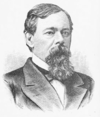 Myron H. McCord (Merrill) | Republican | March 4, 1889 – March 3, 1891 | 51st | Elected in 1888. Lost re-election. | |
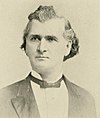 Thomas Lynch (Antigo) | Democratic | March 4, 1891 – March 3, 1895 | 52nd | Elected in 1890. | |
| 53rd | Re-elected in 1892. Lost re-election. |  | |||
 Alexander Stewart (Wausau) | Republican | March 4, 1895 – March 3, 1901 | 54th 55th 56th | Elected in 1894. Re-elected in 1896. Re-elected in 1898. Retired. | |
 Webster E. Brown (Rhinelander) | Republican | March 4, 1901 – March 3, 1903 | 57th | Elected in 1900. Redistricted to the 10th district . | |
 Edward S. Minor (Sturgeon Bay) | Republican | March 4, 1903 – March 3, 1907 | 58th 59th | Redistricted from the 8th district and re-elected in 1902. Re-elected in 1904. Lost renomination. |  |
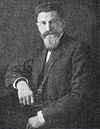 Gustav Küstermann (Green Bay) | Republican | March 4, 1907 – March 3, 1911 | 60th 61st | Elected in 1906. Re-elected in 1908. Lost re-election. | |
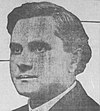 Thomas F. Konop (Green Bay) | Democratic | March 4, 1911 – March 3, 1917 | 62nd | Elected in 1910. | |
| 63rd 64th | Re-elected in 1912. Re-elected in 1914. Lost re-election. |  | |||
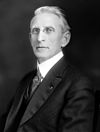 David G. Classon (Oconto) | Republican | March 4, 1917 – March 3, 1923 | 65th 66th 67th | Elected in 1916. Re-elected in 1918. Re-elected in 1920. Retired. | |
 George J. Schneider (Appleton) | Republican | March 4, 1923 – March 3, 1933 | 68th 69th 70th 71st 72nd | Elected in 1922. Re-elected in 1924. Re-elected in 1926. Re-elected in 1928. Re-elected in 1930. Redistricted to the 8th district and lost re-election. | |
 James A. Frear (Hudson) | Republican | March 4, 1933 – January 3, 1935 | 73rd | Redistricted from the 10th district and re-elected in 1932. Retired. |  |
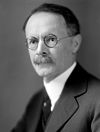 Merlin Hull (Black River Falls) | Progressive | January 3, 1935 – January 3, 1947 | 74th 75th 76th 77th 78th 79th 80th 81st 82nd 83rd | Elected in 1934. Re-elected in 1936. Re-elected in 1938. Re-elected in 1940. Re-elected in 1942. Re-elected in 1944. Re-elected in 1946. Re-elected in 1948. Re-elected in 1950. Re-elected in 1952. Died. | |
| Republican | January 3, 1947 – May 17, 1953 | ||||
| Vacant | May 17, 1953 – October 13, 1953 | 83rd | |||
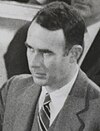 Lester Johnson (Black River Falls) | Democratic | October 13, 1953 – January 3, 1965 | 83rd 84th 85th 86th 87th 88th | Elected to finish Hull's term. Re-elected in 1954. Re-elected in 1956. Re-elected in 1958. Re-elected in 1960. Re-elected in 1962. Retired. | |
 Glenn R. Davis (Waukesha) | Republican | January 3, 1965 – December 31, 1974 | 89th 90th 91st 92nd | Elected in 1964. Re-elected in 1966. Re-elected in 1968. Re-elected in 1970. |  northern Milwaukee County
|
| 93rd | Re-elected in 1972. Lost renomination and resigned early. | 
| |||
| Vacant | December 31, 1974 – January 3, 1975 | 93rd | |||
 Bob Kasten (Brookfield) | Republican | January 3, 1975 – January 3, 1979 | 94th 95th | Elected in 1974. Re-elected in 1976. Retired to run for Governor of Wisconsin. | |
 Jim Sensenbrenner (Menomonee Falls) | Republican | January 3, 1979 – January 3, 2003 | 96th 97th | Elected in 1978. Re-elected in 1980. | |
| 98th 99th 100th 101st 102nd | Re-elected in 1982. Re-elected in 1984. Re-elected in 1986. Re-elected in 1988. Re-elected in 1990. | 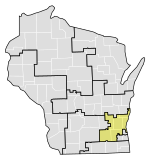 eastern Dodge County , parts of Fond du Lac County , most of Jefferson County , & northeast Milwaukee County , southern Sheboygan County & most of Waukesha County
| |||
| 103rd 104th 105th 106th 107th | Re-elected in 1992. Re-elected in 1994. Re-elected in 1996. Re-elected in 1998. Re-elected in 2000. Redistricted to the 5th district . |  most of Dodge County , part of Fond du Lac County , most of Jefferson County , & northeast Milwaukee County , eastern Sheboygan County & northern Waukesha County
| |||
| District dissolved January 3, 2003 | |||||










